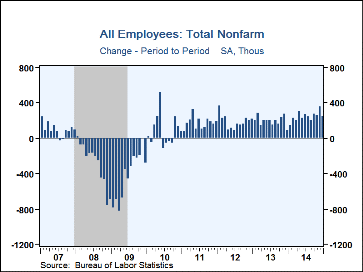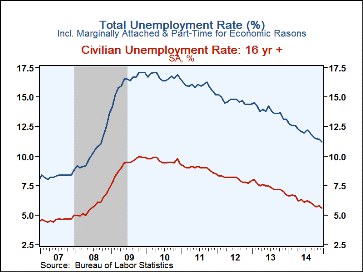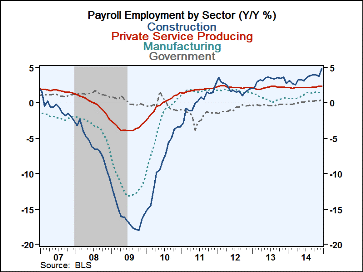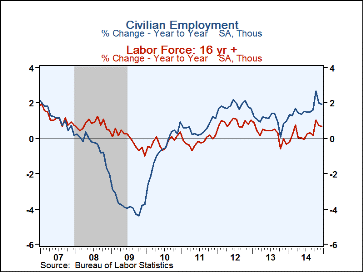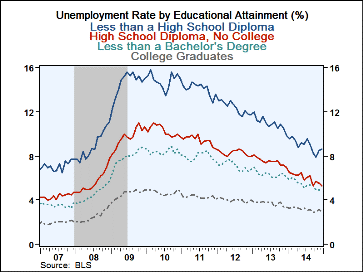 Global| Jan 09 2015
Global| Jan 09 2015U.S. Payroll Employment Growth Improves in 2014; Unemployment Rate Falls to 2008 Low
by:Tom Moeller
|in:Economy in Brief
Summary
The job market remains firm. Nonfarm payroll jobs grew 2.527 million (1.9%) last year, the strongest increase since 2000. Moreover, the 252,000 rise during December (2.1% y/y) followed upwardly revised gains of 353,000 and 261,000 [...]
The job market remains firm. Nonfarm payroll jobs grew 2.527 million (1.9%) last year, the strongest increase since 2000. Moreover, the 252,000 rise during December (2.1% y/y) followed upwardly revised gains of 353,000 and 261,000 during the prior two months, earlier reported as 321,000 and 243,000. A 243,000 increase had been expected in the Action Economics Forecast Survey. Firm job gains were logged across sectors, but construction's 48,000 increase (4.9% y/y) was the largest monthly gain since January of last year. The unemployment rate declined to 5.6%, the lowest point since June 2008. A 5.8% rate had been expected. The overall unemployment rate including marginally attached and part time workers for economic reasons fell to 11.2%.
From the payroll employment survey, employment increased 252,000 last month. The construction sector's strong rise of 48,000 was accompanied by a 17,000 increase in the factory sector, below the pace of the prior two months. The service sector produced a lessened 173,000 employment gain last month, but for the year the 2.2% increase was the third such gain in a row, the strongest performance since the late-1990s. Professional & business services employment improved 52,000 (3.9% y/y), including a 14,700 rise (7.8% y/y) in temporary employment. Jobs in health care & social assistance gained 43,700 (2.4% y/y). Leisure & hospitality employment advanced 36,000 (2.9% y/y) and financial sector payrolls grew 10,000 (1.9% y/y). Job gains were rounded out by a 10,000 rise (1.9% y/y) in wholesale trade and a 7,700 increase (1.6% y/y) in retail trade, which was by far the weakest gain since a decline in August. Jobs in the government sector grew 12,000 (0.4% y/y) led by a 7,000 increase (0.4% y/y) in state government. Local government jobs rose 4,000 (0.6% y/y) and federal government employment ticked up 1,000 (-0.6% y/y).
Employment growth remained fairly diffused last month with 63.6% of industries increasing jobs, though that was down from the November peak of 69.7%. During the last three months, 73.7% of industries raised job levels. Factory sector employment was raised in 58.0% industries and by 70.4% during the last three months.
The length of the average workweek held at its recovery high of 34.6 hours. The factory sector workweek dipped to 41.0 hours but the construction workweek improved to a record 39.4 hours. The private services workweek held for the fourth month at 33.4 hours. The index of aggregate hours worked (employment times hours) rose 0.9% (2.8% y/y) in the fourth quarter. During the last ten years, there has been a 69% correlation between the change in hours worked and the change in real GDP.
Average hourly earnings declined 0.2% (+1.7% y/y), reversing November's rise. Manufacturing sector earnings were off 0.2% (+1.3% y/y). Private service sector earnings also fell 0.2% (+1.7% y/y) while earnings in the information sector slipped 0.1% (+2.7% y/y). Financial sector earnings declined 0.2% (+2.1% y/y).
From the household employment survey, the unemployment rate's decline to 5.6% reflected an employment rise of 111,000 (1.9% y/y) and a labor force decline of 273,000 (+0.7% y/y). The labor force participation rate returned to 62.7%, the lowest level since 1977, reversing a rise to 67.1% averaged in the late-1990s. The civilian population grew a modest 0.9% last year, about the same as in 2013.
The average duration of unemployment was fairly steady m/m at 32.8 weeks, though that was down from 39.4 weeks in 2012. Long-term unemployment declined as 21.4% of those unemployed were out of work for more than 52 weeks, down from 31.4% in 2011.
By educational attainment, the unemployment rate for those with less than a high school diploma was 8.6%. For those with a diploma but no college, it was 5.3%. For high school graduates with less than bachelor's degree, it was 4.9% and for those with a bachelor's degree or higher, it was 2.9%.
The figures referenced above are available in Haver's USECON database. Additional detail can be found in the LABOR and in the EMPL databases. The expectation figures are from Action Economics and are in the AS1REPNA database.
Declining Labor Force Participation and Its Implications for Unemployment and Employment Growth from the Federal Reserve Bank of Chicago can be found here.
| Employment: (M/M Chg., 000s) | Dec | Nov | Oct | Y/Y | 2014 | 2013 | 2012 |
|---|---|---|---|---|---|---|---|
| Payroll Employment | 252 | 353 | 261 | 2.1% | 1.9% | 1.7% | 1.7% |
| Previous | -- | 321 | 243 | -- | -- | -- | -- |
| Manufacturing | 17 | 29 | 24 | 1.5 | 1.1 | 0.7 | 1.7 |
| Construction | 48 | 20 | 16 | 4.9 | 3.6 | 3.3 | 2.1 |
| Private Service Producing | 173 | 294 | 213 | 2.4 | 2.2 | 2.2 | 2.2 |
| Government | 12 | 8 | 6 | 0.4 | 0.2 | -0.3 | -0.8 |
| Average Weekly Hours - Private Sector | 34.6 | 34.6 | 34.5 | 34.3 (Dec.'13) |
34.5 | 34.5 | 34.4 |
| Private Sector Average Hourly Earnings (%) | -0.2 | 0.2 | 0.1 | 1.7 | 2.0 | 2.1 | 1.9 |
| Unemployment Rate (%) | 5.6 | 5.8 | 5.7 | 6.7 (Dec.'13) |
6.1 | 7.4 | 8.1 |
Tom Moeller
AuthorMore in Author Profile »Prior to joining Haver Analytics in 2000, Mr. Moeller worked as the Economist at Chancellor Capital Management from 1985 to 1999. There, he developed comprehensive economic forecasts and interpreted economic data for equity and fixed income portfolio managers. Also at Chancellor, Mr. Moeller worked as an equity analyst and was responsible for researching and rating companies in the economically sensitive automobile and housing industries for investment in Chancellor’s equity portfolio. Prior to joining Chancellor, Mr. Moeller was an Economist at Citibank from 1979 to 1984. He also analyzed pricing behavior in the metals industry for the Council on Wage and Price Stability in Washington, D.C. In 1999, Mr. Moeller received the award for most accurate forecast from the Forecasters' Club of New York. From 1990 to 1992 he was President of the New York Association for Business Economists. Mr. Moeller earned an M.B.A. in Finance from Fordham University, where he graduated in 1987. He holds a Bachelor of Arts in Economics from George Washington University.


